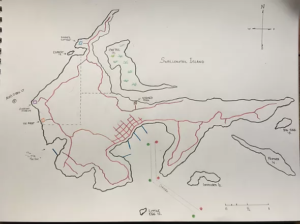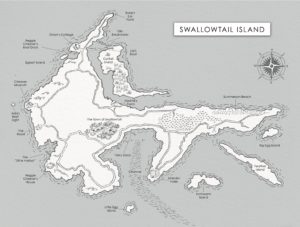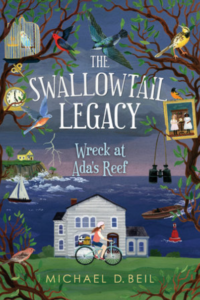“Why are we learning about maps in English class? (and other just questions)”
I know that I’m the minority here, but in my humble opinion, civilization as we know it began its final descent when swarms of satellites filled the sky and GPS replaced the paper maps that used to fill our glove compartments. In my teaching days, I was mildly concerned when more and more of my students (high school freshmen) were unable to tell time on the analog clock on my classroom wall. But when I realized that many of them had no idea of how to read a map, I was absolutely horrified. What would happen, I asked, if the power went out, or the satellites crashed, or hackers changed all of the street names?
I’ve been accused of being a bit of a Luddite, but that’s not really it. It’s not that I fear technology, it’s just that I love maps. And literary maps—usually found printed on a book’s endpapers—well, those are the best. Whether it’s Milo on the road from Dictionopolis to Digitopolis, or Frodo and Sam crossing the Dead Marshes, the voyage of the Goblin in We Didn’t Mean to Go to Sea, or David Balfour wandering across Scotland in Kidnapped, there’s not much that I enjoy more than tracing characters’ paths across a map found in a favorite novel.
One of my favorite parts of writing The Swallowtail Legacy 1: Wreck at Ada’s Reef was drawing and redrawing the map of Swallowtail Island. The book starts off with the protagonist and her family arriving by ferry at the island, which is in western Lake Erie. It’s fictional, a composite of some islands that I’ve gotten to know over the years: Put-in-Bay, Mackinac, Nantucket, Carleton, Harker’s, and more. For instance, I’ve always loved the “no cars” aspect of Mackinac Island, so I made that part of Swallowtail (although golf carts are allowed).
The map of the island grew out of necessity; as I was writing, I needed to be able to see the buoy at Ada’s Reef where the fatal accident occurred so long ago. And when Lark and Pip ride their bikes out to Rabbit Ear Point at night to see if the light on the buoy is visible from Dinah Purdy’s porch (possibly a key piece of evidence in the case), I want readers to follow along on the map, to see the buoy for themselves, in a sense. I don’t have an Excel spreadsheet full of data to prove it, but I firmly believe that the kind of kid who does refer to the map is going to remember more details.
If you choose a book for a classroom read that has a map, I suggest creating a bulletin-board-size copy of the map (The easiest way to do it is to project it onto a big sheet of paper and trace it; get students to help transfer the details that you want to include.) Whenever I taught The Fellowship of the Ring, I had a big version of the map on a bulletin board and used different colored push pins to mark the progress of the members of the Fellowship—much more effective than having students trying to figure out where they were on the four part map that’s included in the book.
As an English teacher, one of my goals was to help my students be more careful readers. (I’m hardly alone here; there are more strategies for close reading than there are teachers, I think.) My own experience tells me that even kids who are good readers don’t always read very carefully. The classic short story, Richard Connell’s “The Most Dangerous Game,” which appears in lot of high school English textbooks (and is now in the public domain) provides the basis for one of my favorite assignments: draw a map of Shiptrap Island that shows where all of the key plot events occur. (A caveat: I’m not the only teacher to think of this, and student-created maps of the island can be found online.) The assignment works best as an in-class group project, with each group having to justify their decisions using the text for support.
Other times, when students were writing narrative essays about their neighborhood (inspired by Charles Dickens’s “sketches” of London life), they had to include a hand drawn map of their neighborhood with key locations from the essay indicated and captioned. It’s a great opportunity for artistic students, and those with an eye for detail, to shine, and, as an added bonus, the visual aids made grading the papers loads more interesting for me!
Published February 15, 2022 by Pixel + Ink
About the Book: In a time not long after the fifth extinction event, Edgar Award-nominated author Michael D. Beil came of age on the shores of Pymatuning Lake, where the ducks walk on the fish. (Look it up. Seriously.) He is the author of the Red Blazer Girls series, Summer at Forsaken Lake, Lantern Sam and the Blue Streak Bandits, and Agents of the Glass: A New Recruit. For reasons that can’t be disclosed until September 28, 2041, he now lives somewhere in Portugal with his wife and their two white cats, Bruno and Maisie. He still gets carsick if he has to ride in the back seat for long and feels a little guilty that he doesn’t keep a journal. For more on the author and his books, visit him online atMichaelDBeil.com.
About the Author: In a time not long after the fifth extinction event, Edgar Award-nominated author Michael D. Beil came of age on the shores of Pymatuning Lake, where the ducks walk on the fish. (Look it up. Seriously.) He is the author of the Red Blazer Girls series, Summer at Forsaken Lake, Lantern Sam and the Blue Streak Bandits, and Agents of the Glass: A New Recruit. For reasons that can’t be disclosed until September 28, 2041, he now lives somewhere in Portugal with his wife and their two white cats, Bruno and Maisie. He still gets carsick if he has to ride in the back seat for long and feels a little guilty that he doesn’t keep a journal. For more on the author and his books, visit him online atMichaelDBeil.com.
Thank you, Michael, for your guest post!





I enjoyed your comments Mr Beale. I’m a retired librarian who also (so far just select poems in publications. And I am related to your wife whom I met in 2018. Her mother Pat us my cousin. So pleased to read your comments. I feel the same way about maps.